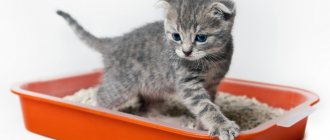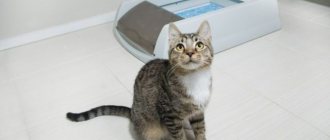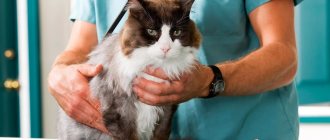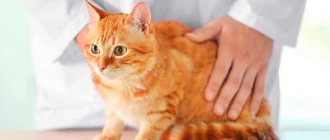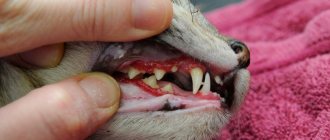Causes of blood
Discharge of blood from a cat's anus is not a typical phenomenon; it indicates an illness in the animal. It can be caused by various reasons:
- With constipation, blood appears due to damage to the intestines. It is released in small quantities during bowel movements. You need to give your cat a remedy for constipation and lubricate the anus with Vaseline, oil or soap. If there is no blood when the animal goes to the toilet again, then it is not necessary to consult a doctor.
- If blood in the feces is a regular occurrence, then this indicates a serious problem with the cat’s health; in order to treat your pet, you need to find the reason why the disease appeared. The main causes of blood in a cat identified by veterinarians are as follows:
- Allergy;
- Colitis;
- Parasites;
- Pancreatitis;
- Tumor;
- Poisoning;
- Damage to the intestines or anus;
- Thromboembolism.
© shutterstock
Bleeding should not be ignored. It can result in complications that are difficult or impossible to treat. Any part of the gastrointestinal tract can bleed. The higher the focus of the disease, the darker the blood released from the anus. If there is a problem with the stomach or upper intestine, it will be dark in color, and if there is a problem with the lower intestine, its color will be scarlet.
Parasites
If your cat is bleeding from the anus, the cause may be helminths. They are especially dangerous for street animals. Infection can occur from other animals or through food. You should not give cats fish and meat that have not been heat-treated. In order to prevent infection, periodic deworming should be carried out. Cats that are kept without walking should also be subjected to it. Anthelmintic drugs are not able to cope with all possible parasites. If they do not help, you need to get tested to identify the parasite. After diagnosis, the doctor will prescribe suitable treatment.
Treatment options
The first thing you need to do is go to the veterinary clinic. There they will conduct a diagnosis and identify the cause of bleeding from the cat’s anus. The doctor will prescribe treatment and give advice on feeding the animal. To make a diagnosis, a stool test is performed and, if necessary, a colonoscopy.
If your pet is infected with parasites, then it is not scary. It can be cured by adjusting the diet and an anthelmintic drug prescribed by a veterinarian. These measures will remove worms from your pet's intestines. The diet is also changed in case of allergies.
If a cat is bleeding from the anus due to an infection, treatment should be carried out with antibiotics. In colitis, the animal's stool contains bloody mucus. It is treated with suppositories, ointment, tannin, and copper sulfate solution. The disease has several forms, so you cannot treat the cat yourself.
Cats may develop thromboembolism. This is a disease in which blood clots and blood clots form. It can develop rapidly. Manifested by diarrhea with blood clots. Usually the prognosis is not favorable. But if detected at the onset stage, it will give the cat a chance to live. Blood from the anus can signal the appearance of a tumor. It can be benign or malignant. It is very difficult to diagnose, especially if the tumor is small. The doctor does not always make the correct diagnosis. To check, it is recommended to do an ultrasound.
© shutterstock
Due to intestinal problems: diarrhea, constipation, the mucous membrane is injured and cracks may occur. They can be complicated by hemorrhoids. As feces pass through, they become inflamed. They hurt and bleed. In this case, blood from the anus appears after bowel movement. At an early stage it is treated with suppositories and ointments.
The appearance of blood in a cat's stool may be accompanied by other symptoms. You also need to pay attention to them in order to make a correct diagnosis.
- The animal began to pee frequently;
- Vomit;
- The cat refuses to eat or eats very little;
- The animal is rapidly losing weight;
- Thirst;
- Lethargy, lack of usual interest in the environment.
In order to find the cause of the bleeding in time and not cause a deterioration in the animal’s condition, you need to contact a veterinarian. A timely diagnosis gives a better chance of recovery. You can’t put it off and risk your cat’s health.
Types and causes of discharge
For the first time, discharge from the anus is detected during bowel movements or stains are observed on the underwear. Already at this moment you need to forget about modesty and consult a doctor. It is the embarrassment regarding such a delicate problem that leads to delays in visiting the clinic and ultimately to complications.
If there is an admixture of mucus in the discharge, then the problem is not purely proctological in nature. Main reasons:
- food poisoning;
- poor nutrition;
- vascular diseases;
- degenerative tissue changes.
If, in addition to discharge, it becomes difficult for a person to retain the contents of the intestines, then we may be talking about one of the following problems:
- tumors;
- Crohn's disease;
- haemorrhoids;
- fecal stones;
- irritable bowel syndrome;
- mechanical damage to the pelvic floor muscles;
- syphilis;
- gonorrhea;
- herpes;
- anal fissures;
- genital warts;
- pararectal fistulas;
- bowel prolapse;
- consequences of surgery.
In a pathological environment, mucus forms. It may contain an admixture of pus, then a liquid with an odor is released from the anus.
Bacteria begin to actively multiply and cause inflammation of the mucous membranes when the body is weakened, during vitamin deficiency, or under stress. Additionally, the patient has elevated body temperature and signs of intoxication. Depending on the cause, there may be pain or discomfort in the area of the inflamed organ.
When it leaks from the anus, the pathology is accompanied by symptoms such as stool disturbance, flatulence, frequent urge to defecate, and discomfort is constantly felt in the anus.
Hemorrhoids, in addition to mucous discharge, are accompanied by blood discharge, itching and burning in the anal area. The disease is characterized by an enlargement of the node during blood flow.
Prolonged mucous discharge leads to skin irritation, itching, anal fissures, and pain during bowel movements.
Typically, such discharge does not cause a dangerous disease. When oily fluid is released from the anus, the cause may be poor diet and taking certain medications.
Oily fluid from the anus in an adult appears after eating fatty fish, dietary supplements, large amounts of vegetables, oral contraceptives, etc.
Finding the problem is not difficult. For the above reasons, the patient's stool is disrupted, it is poorly washed off, and there is an oily sheen.
Oily discharge from the anus can be additional symptoms of certain pathologies of internal organs, namely:
- hemorrhoids;
- inflammation of the pancreas;
- inflammation of the gallbladder;
- intestinal inflammation.
The above diseases also have other symptoms, for example, pain in the abdomen or hypochondrium, abnormal bowel movements, and deterioration in general condition.
Discharge of clear liquid from the anus appears after taking low-quality products. The second reason is irritable bowel syndrome. In both cases, liquid discharge indicates a disturbance in the intestinal microflora. The patient complains of a feeling of fullness in the intestines, abnormal stool, and flatulence.
Carefully! The process of fluid exiting the anus is not felt by a person. Discharge can only be detected in stool or on underwear. Therefore, patients often delay their visit to the doctor without knowing it.
If fluid discharge from the rectum appears at rest and not during bowel movements, then the problem is inflammatory in nature. Sometimes the cause is a poorly developed sphincter, then gas incontinence is also observed.
Foam from the anus in an adult indicates inflammatory diseases of the large intestine. The possibility of tumor or adenoma formation cannot be ruled out.
Orange discharge from the anus indicates excessive secretion of bile. Improper liver function results in a mucous or foamy yellow discharge from the anus that has an unpleasant odor.
White discharge or white streaks indicate a fungal infection of the body, in particular the anus or colon. Mucus in the anus in women may appear after thrush appears. The fungus appears during times of stress, decreased immunity, hormonal changes, and poor nutrition.
What is inflammation of the paraanal glands?
The paraanal glands are located near the animal's anus. Their task is to empty the unpleasant-smelling secretion, which has a viscous consistency. The cat must empty itself of this fluid by tensing nearby muscles. If the glands are filled with thickened secretion, then it is absorbed into the blood and spread throughout the body.
If the cat is not treated at this stage, inflammation will begin and spread to nearby tissues. As a result, an abscess will occur, which causes pain, first when visiting the toilet, and then in a calm state. In the future, the abscess can lead to blood poisoning. If the necessary treatment is not carried out, the animal may die.
There are different situations when kittens, cats and cats start bleeding and here you need to know what happens and why in most cases. Such knowledge allows you to immediately decide on first aid, and also allows you to roughly understand how the treatment of the problem that has arisen will proceed.
Causes of bleeding most often diagnosed by veterinarians
Usually, bloody discharge from the anus in cats frightens owners of furry pets, since this is not a typical occurrence. At the first signs, you need to take a closer look at the animal and its behavior. In young cats, blood may flow not from the butt at all, but from the vagina after a spontaneous abortion during pregnancy.
Bleeding from a cat's anus can lead to serious complications.
The cat is bleeding from the anus after using the toilet for reasons...
Discharge of blood from a cat's anus is not a typical phenomenon; it indicates an illness in the animal. It can be caused by various reasons:
- With constipation, blood appears due to damage to the intestines. It is released in small quantities during bowel movements. You need to give your cat a remedy for constipation and lubricate the anus with Vaseline, oil or soap. If there is no blood when the animal goes to the toilet again, then it is not necessary to consult a doctor.
- If blood in the feces is a regular occurrence, then this indicates a serious problem with the cat’s health; in order to treat your pet, you need to find the reason why the disease appeared. The main causes of blood in a cat identified by veterinarians are as follows:
- Allergy;
- Colitis;
- Parasites;
- Pancreatitis;
- Tumor;
- Poisoning;
- Damage to the intestines or anus;
- Thromboembolism.
Bleeding should not be ignored. It can result in complications that are difficult or impossible to treat. Any part of the gastrointestinal tract can bleed. The higher the focus of the disease, the darker the blood released from the anus. If there is a problem with the stomach or upper intestine, it will be dark in color, and if there is a problem with the lower intestine, its color will be scarlet.
The inflammatory process can occur due to:
- Frequent constipation of the animal, because at the moment of strain with which the intestines are emptied, the gland ducts become clogged.
- Feeding chicken or fish bones.
- Due to the fighting nature of the pet.
- Decreased muscle tone.
Blood from the anus in animals, like people, is an abnormal phenomenon that indicates the presence of a disease. A small amount of blood with severe constipation can be caused by mechanical damage, in which case you need to give the cat a remedy for constipation - Vaseline oil or Duphalac - and observe. If this does not happen again next time, there is no need to go to the doctor for examination.
It’s another matter if blood appears regularly and in fairly large quantities. There may be several reasons for this phenomenon. Firstly, blood in the anus often indicates damage to the gastrointestinal tract and digestive disorders, but a pet owner without a veterinary education will not be able to independently determine the source of the lesion.
Although some assumptions can be made based on the color of the blood: bright red blood indicates that the problem is localized in the rectum or in the anus itself, and a darker, brownish tint is a symptom of a disease in the upper intestines. In any case, you need to contact a veterinarian.
Secondly, it could be colitis - inflammation in the colon, a very unpleasant disease that, if not treated in a timely manner, can lead to the development of complications. As a rule, with colitis the bleeding is profuse, mixed with mucus.
Thirdly, the cause of the appearance of blood may be helminths or worms - parasites that damage the intestinal walls and continue to multiply, disrupting digestion.
As sad statistics show, women in the postpartum period are the first to be at risk for rectal disease. This disease is caused by the fact that in pregnant women or women who have just given birth, painful cracks form in the anus. When blood flows from the anus after childbirth. this may be the first symptom of rectal problems.
Causes of blood from the anus
We can say that hemorrhoids and pregnancy are inseparable. Therefore, during pregnancy, blood from the anus is a fairly common occurrence. As a rule, the problem of hemorrhoids begins to bother you in the last months of pregnancy, as well as immediately after childbirth. As a rule, the cause of this unpleasant phenomenon is constipation and hard stools, which is very common in pregnant women and women who have just given birth. If a woman strains strongly during bowel movements, it can cause hemorrhoids to bleed.
The formation of cracks leads to bleeding from the anus. These are painful lesions in the anal area that occur in pregnant women due to frequent constipation and the passage of hard feces.
If blood flows from the anus, this may be a sign of damage to the rectum and colon. During pregnancy, bleeding from the rectum does not pose any threat and is not a sign of a serious problem. This phenomenon is associated with significant changes in the position of the internal organs, in particular the enlargement of the uterus, which puts strong pressure on the rectum, resulting in blood stagnation. After childbirth, the woman’s body recovers and, as a rule, this problem disappears.
When blood flows from the anus after childbirth, the young mother is bothered by discomfort and pain. Hemorrhoids can be located both externally and internally. In the case of internal hemorrhoids, bleeding is observed more often, as the nodes are pinched and they begin to bleed.
In cases where there is bleeding from the anus, treatment is prescribed depending on the stage of hemorrhoids. The initial stage of hemorrhoids involves treatment with diet correction, as well as a special hygiene regimen. In later stages, drug treatment is required. In case of severe hemorrhoids, surgery cannot be avoided.
2017-12-27 18:23 Sometimes a woman may experience bleeding from the anus during pregnancy. This leads to bleeding from the anus during stool in men, reasons. Anal bleeding with
blood from the anus without pain in men
Diet for cholecystitis - what foods can you eat, candy and sweets, fruits, Diet for cholecystitis: how to eat properly so as not to get complications; what fruit
Folk remedies In ancient times, our ancestors used folk remedies for treating the liver. The functions of the liver, its diseases and treatment are described. Cleaning recipes are provided.
If the free T4 hormone is elevated, symptoms usually include: - sweating. What can your thyroxine level tell you? If T4 is clearly elevated, then this is considered
You can drink coffee during pregnancy, but not everyone. Those women can and should drink, “Can you drink motherwort during pregnancy” - read the posts and participate in discussions
Hello, Galina.
Unfortunately, it is not entirely clear from your question whether the blood got onto the paper by accident, that is, dripped from the vagina while you were wiping yourself, or whether the blood got onto the paper from the anus.
If the blood on the paper came from the anus, then the gynecologist has absolutely nothing to do with it, and moreover, the bleeding cannot in any way be a consequence of hormonal imbalances. The rectum has nothing to do with gynecology.
Of course, sometimes women, as well as men, may experience bleeding from the anus of varying intensity. Blood may remain on toilet paper, be present on the surface of stool, or appear on underwear. Most often, blood discharge from the anus is observed after defecation, pushing and physical activity.
- Cracks in the rectum. In this case, bleeding most often appears after defecation, straining, or physical activity. Factors contributing to the appearance of cracks in the rectum are constipation, diarrhea, anal sex, and so on.
- A disease such as hemorrhoids also causes bleeding from the anus if, after physical exertion, defecation, or anal sex, the hemorrhoidal node ruptures.
- The formation of diverticula and polyps in the large intestine can also cause blood discharge from the anus.
- The most terrible cause of blood in the stool and blood discharge from the anus is cancer of the rectum and large intestine.
- The appearance of blood clots and mucus in the stool released during sudden diarrhea may be a consequence of acute intestinal infections. If, in addition to blood, pus is also released, then this indicates an infectious cause of the disease, most often associated with the entry of sexually transmitted pathogens into the rectum.
- Bleeding from the anus can be caused by the presence of worms in the body, since worms can damage the walls of the small intestine.
- Often, blood in the stool is caused by diseases such as Crohn's disease or ulcerative colitis.
Naturally, if blood discharge appears from the anus, you should not wait until the disease begins to progress, but consult a proctologist. If blood gets onto the paper from the vagina, then you should consult a gynecologist, since intermenstrual bleeding from the vagina can be symptoms of various diseases.
The main causes of bleeding from under the tail
If a cat is bleeding under its tail, the following factors may be the cause:
- Physiological process, estrus. In most cases, the flow of blood represents the process of readiness of the reproductive system to bear kittens. In this condition, blood is released in small volumes from the loop area. There is no need to panic, but to make sure that nothing threatens your pet’s health, it is recommended to consult a veterinary clinic, examine the cat and become familiar with the rules of feeding and nutritional supplements;
- Diseases of the digestive system. In this case, the cat is bleeding under the tail, and you may notice bloody discharge in the feces. In this condition, systematic and comprehensive treatment with antibiotics, anti-inflammatory, and wound-healing drugs is necessary. During treatment, it is very important to follow a diet; solid feed mixtures are excluded, as well as prohibited foods from the common table. Only a specialist can determine the cause of bleeding based on the examination and test results obtained. Peptic ulcers and opened fistulas in the rectal area are detected;
- Inflammatory processes localized in the uterus. If a cat is bleeding from under its tail, the cause may be a congenital or acquired pathology of the reproductive organs. In this case, the veterinarian will conduct an ultrasound examination and determine the exact diagnosis. Afterwards, he prescribes effective therapy that eliminates the underlying disease, as well as accompanying symptoms;
- Miscarriage. Pregnant individuals may experience spontaneous abortion for various reasons. At this moment, cats try to constantly lick the area of the loop, eliminating all blood and mucus secretions. At the same time, the kittens are still inside the pet’s womb. Fetal death can occur at any stage of gestation. After the development of the kittens stops, the mother cat starts bleeding from the uterus. Thus, the animal’s body tries to get rid of dead fruits. It is very important to notice this phenomenon in a timely manner and take your pet to the clinic to remove dead fetuses. If timely assistance is not provided, the animal may die from intoxication from the kittens decomposing inside;
- Injuries and strong impacts. Bleeding may be profuse or barely noticeable. The cause is often blows and bruises. A dangerous symptom can be observed in both male and female cats. Rupture of internal organs as a result of impacts causes the death of the pet. Urgent medical attention is required. In severe cases, surgery is recommended;
- Ectopic pregnancy. Pathological processes involve the development of fetuses outside the uterine cavity. As the fruit grows, tissue ruptures are observed. As a result, the cat starts bleeding from under its tail. To prevent a dangerous and serious condition, it is necessary, after the owner finds out about the pregnancy of his ward, to take her to the clinic for an ultrasound to study and clarify the correct development of the fetus;
- Childbirth. In cats, after the birth of kittens, there may be bloody discharge from the loop, which the pet licks off. In this case, do not panic, this is a normal physiological process. The bleeding will stop on its own within two days. If the symptom is observed for a long time and in large quantities, then you should consult a doctor;
- Urolithiasis disease. The presence of stones in the bladder also causes characteristic symptoms. Depending on the severity of the disease, appropriate treatment is carried out. In the early stages, painkillers and antispasmodics are recommended. In severe cases, surgery is prescribed.
Bleeding from the anus: causes
3.33 6
Bleeding from the anus can be caused by a variety of reasons. If you have such a symptom, you should consult a doctor as soon as possible.
Bleeding from the anus can be caused by both mechanical trauma and some serious diseases. Such a symptom should alert a person and become a reason to immediately consult a doctor. Even if the bleeding has stopped for a while, this does not mean that the disease has disappeared. After some time, the symptom may recur again, sometimes in a more severe form, as the disease progresses.
Hemorrhoids are one of the most common causes of anal bleeding. Most often, bleeding appears as bright red spots on toilet paper, underwear, or as droplets in the toilet. In some cases, there is a rupture of the hemorrhoidal node, which entails heavy bleeding, which cannot be ignored.
Bleeding from hemorrhoids occurs due to the fact that feces have a damaging effect on hemorrhoidal cones. As a rule, such cases are painless. However, pain during bleeding may occur if hemorrhoids are combined with an anal fissure.
Injuries to the rectal mucosa occur due to its strong stretching by dense feces. Just as with hemorrhoids, the patient notices droplets of blood on toilet paper, underwear, or directly on the feces. However, in this case, the bleeding is accompanied by severe pain in the anus.
Polyps are benign intestinal neoplasms, which are mushroom-like bodies on a thin stalk. Polyps may not make themselves known for a long time. In some cases, polyps degenerate into a malignant tumor. The surface of the polyps may bleed. The larger the size of the polyp, the more often and more easily its surface is damaged.
With diverticulosis, protrusions and pouches form on the intestinal walls. Perhaps this pathology is caused by weakness of the intestinal wall. The disease can also develop with increased pressure in the digestive tract.
In some cases, diverticula may not cause any unpleasant symptoms. However, when they become inflamed, the sac may rupture, which is accompanied by elevated temperature, muscle tension in the lower abdomen, and when blood vessels are involved in pathological changes, bleeding is noted.
If inflammation of the diverticulum occurs in the sigmoid colon, then the blood from the anus will be scarlet, and with diverticula of the colon, dark and even black blood may be discharged. This condition is very dangerous and requires immediate surgical intervention.
Causes
The first and most common reason is estrus. This is a natural and physiological process of every female cat, which occurs at a certain age. This signals that her body is ready for fertilization and childbearing. Blood, in small portions, is released from the cat's vagina, which is a symptom of her puberty.
Other causes of bleeding in cats:
- the presence of a disease of the digestive system - blood in the stool;
- uterine bleeding in cats of various pathologies;
- spontaneous termination of pregnancy. If this happened in the early stages, then the person may not notice it. The cat constantly licks its perineum and can remove this secretion and area by swallowing it. But future kittens that are still in the womb may die at different stages. This will lead to heavy bleeding from the uterus. If the embryos remain there for a long time, then they begin to deteriorate and pus and an unpleasant odor are already added to the blood, the pet can develop serious inflammation and blood poisoning, even death;
- the next problem is heavy uterine bleeding. They can flow very quickly and be a consequence of serious injuries or damage. During pregnancy, there is a risk of a severe infection entering the placenta, but with quick and proper treatment there is a great chance of saving the kittens;
- ectopic pregnancy. When the fetus develops outside the uterine cavity, or when it ruptures, they continue to develop. Both cases end in fetal death and are removed through surgery. If help is not provided on time, sepsis, necrosis and death of the pet occur. If the owner paid attention to the symptoms in time, then there is a great opportunity to save the life of the cat and its ability to reproduce, but there is no chance of saving the embryos.
- After the birth of kittens, normally, their mother’s bleeding lasts 10-15 days. During such a period, she needs proper care, care and guardianship, and examination by a veterinarian. If the discharge stops suddenly, blood stagnation is quite possible, which is very bad. A visit to a veterinary clinic is required;
- streaks of blood at the root of the tail may indicate urolithiasis in your pet. The presence of stones or sand in the kidneys is provoked by poor diet and consumption of heavy water. This disease requires immediate treatment.
How to recognize the disease?
Inflammation of the paraanal glands can be recognized by the following symptoms:
The first thing you need to do is go to the veterinary clinic. There they will conduct a diagnosis and identify the cause of bleeding from the cat’s anus. The doctor will prescribe treatment and give advice on feeding the animal. To make a diagnosis, a stool test is performed and, if necessary, a colonoscopy.
If a cat is bleeding from the anus due to an infection, treatment should be carried out with antibiotics. In colitis, the animal's stool contains bloody mucus. It is treated with suppositories, ointment, tannin, and copper sulfate solution. The disease has several forms, so you cannot treat the cat yourself.
Cats may develop thromboembolism. This is a disease in which blood clots and blood clots form. It can develop rapidly. Manifested by diarrhea with blood clots. Usually the prognosis is not favorable. But if detected at the onset stage, it will give the cat a chance to live. Blood from the anus can signal the appearance of a tumor.
Due to intestinal problems: diarrhea, constipation, the mucous membrane is injured and cracks may occur. They can be complicated by hemorrhoids. As feces pass through, they become inflamed. They hurt and bleed. In this case, blood from the anus appears after bowel movement. At an early stage it is treated with suppositories and ointments.
The appearance of blood in a cat's stool may be accompanied by other symptoms. You also need to pay attention to them in order to make a correct diagnosis.
- The animal began to pee frequently;
- Vomit;
- The cat refuses to eat or eats very little;
- The animal is rapidly losing weight;
- Thirst;
- Lethargy, lack of usual interest in the environment.
In order to find the cause of the bleeding in time and not cause a deterioration in the animal’s condition, you need to contact a veterinarian. A timely diagnosis gives a better chance of recovery. You can’t put it off and risk your cat’s health.
Inflammation of this extremely unpleasant disease occurs in several ways. The sooner the owner seeks help from a veterinarian, the more successful and easier the treatment will be. The most commonly used methods are:
- Mechanical cleaning of cats involves gentle pressure on the inflamed area with the index finger and thumb to release the glands from the accumulated consistency. Cleaning is carried out with gauze napkins.
- If during cleaning it was not possible to achieve the desired result, then a thumb is inserted into the animal’s anus and pressed on the overcrowded glands. Externally, the same procedure is carried out using the index finger. Cleaning must be done until all the accumulated secretion is released.
- For milder conditions, you need to lubricate the inflamed area with Levomekol ointment or use suppositories inserted into the animal’s anus. To do this, use 1/4 suppositories with Levomycetin or Ichthyol. If treatment is carried out using ointment, then it is necessary to ensure that the animal does not lick the anus area, and if using suppositories, then it is important to adjust the time the pet goes to the toilet. After some time, you need to treat under the cat’s tail with a manganese solution. Such therapy should be carried out for about 2 weeks.
- When the abscess begins, the anus is treated with antiseptics: Miramistin, Chlorhexidine, Hydrogen Peroxide.
- If the abscess develops into the formation of fistulas, then their cavity must be washed out using a syringe with the needle previously removed. You need to fill the syringe with the above-mentioned antiseptics and inject them into the cavity of the fistula. Then apply tampons soaked in Streptocidal, Syntomycin ointments or Levomekol. Cats usually do not lick Levomekol, so it is most often prescribed by veterinarians. If therapy is carried out for at least 1 month, the fistulas will heal and the inflammation will go away.
There is no need to cleanse healthy glands as a preventive measure, as this can lead to a malfunction of the body.
Treatment is selected depending on the cause, which must be determined by a veterinarian. If these are worms, then it is necessary to give the animal anthelmintic drugs according to a specific regimen prescribed by the doctor. You also need to review your cat’s diet and avoid giving it raw fish and meat.
Inflammation of the rectum is treated with a solution of tannin, a solution of copper sulfate, and the introduction of tampons with ointment into the anus. Severe infections should be treated with antibiotics. Treatment of colitis depends on its type: there are acute, bacterial, aosinophilic, chronic and other types. First of all, you need to adhere to a certain diet, you also need to give injections and give tablets of antimicrobial, immunosuppressive and anti-inflammatory drugs.
A qualified veterinarian should treat inflamed anal sacs in a cat. The choice of tactics and method of treatment for inflammation of the paraanal glands in cats depends on several factors: the individual characteristics of the animal’s body, the state of the pet’s immunity, the nature of the disease and the neglect of the pathological process with the presence of complications.
In practice, therapy for the disease is implemented by mechanically cleansing the cavity of the paraanal glands from infected secretions, followed by prescribing a course of antibiotic therapy, novocaine blockades and rectal anti-inflammatory suppositories. In most cases, veterinarians prescribe injectable antibiotics from the gentamicin and penicillin groups to their patients.
To increase the reactivity of a cat’s body and improve the condition of its immune system, the animal needs to introduce food rich in vitamins and nutrients into its daily diet or give synthetic multivitamins for cats, which can be purchased at any veterinary pharmacy.
Chronic inflammation with frequent relapses of the disease requires surgical intervention - resection of the paraanal glands followed by plastic surgery of the perianal zone. Treatment of anal gland abscess in a cat is carried out by surgically opening the anal sacs and draining their cavity.
The anal glands in cats are special exocrine glands located near the anus. The paired organ secretes a thick and foul-smelling secretion, with the help of which the animal marks its territory, thereby designating its possessions, and also attracts individuals of the opposite sex to its person. Under certain conditions, the glands can become inflamed, causing the pet a lot of unpleasant and painful sensations.
Causes of anal bleeding
Blood under the tail in cats appears for the following reasons:
- haemorrhoids;
- anal fissure;
- inflammation of the paraanal glands;
- anticoagulant poisoning;
- isosporosis;
- tumors.
Clinical signs, methods of eliminating the problem, and methods of prevention are not the same. Therefore, each disease is reported in a special section.
How to clean the glands yourself?
When there is no way to get your animal to a veterinarian or call him home, you can try to clean the glands yourself.
Before the procedure, it is advisable to change into old clothes, or even better, put on a protective robe and put on glasses. The manipulations themselves are carried out in the bathroom. The fact is that during cleaning, the secretion, which smells very unpleasant, is splashed in all directions and the chance of being smeared is very high.
Method No. 1
Cleaning is carried out with an assistant who can securely fix the cat. Fixation is carried out using an ordinary diaper, sheet or towel, in which the poor fellow is wrapped, leaving only the tail exposed (the hind legs are also hidden, otherwise there is a chance of being seriously injured).
Further steps consist of squeezing the anus between the thumb and forefinger using a paper napkin. Naturally, gloves are first put on. Gently press on the glands (located at approximately 5 and 8 o'clock on either side of the anus) until fluid appears.
After cleaning, an anti-inflammatory rectal suppository is inserted into the anus. If there are good reasons for this, then the cleansing measures are repeated over time.
Method number 2
It is clear that the above technique will only help in case of slight enlargement of the glands. When the secretion is too viscous, they resort to a more complex and rather painful option for emptying the anal sacs.
Again, fix the pet, put on gloves, lubricate the finger with Vaseline and carefully insert it into the anus:
- feel the gland (dense nodules on the sides of the anus);
- squeeze it between the thumb and index finger;
- with a pressing movement they try to squeeze the secretion out until it comes out completely;
- the same is repeated on the other side.
Method number 3
It is logical that not all owners are mentally prepared for this procedure, so you can resort to another method, which in not very complex and advanced cases turns out to be quite effective:
- the anus and surrounding tissues are lubricated with ointment containing syntomycin or any other anti-inflammatory agent;
- a collar is put on the animal to prevent it from licking the anus;
- At night, a suppository with ichthyol is inserted (the frequency of administration is 10 days). It is important that the cat does not run to the toilet after this, so they clamp the anus with their fingers for a few minutes, thereby fixing the candle inside.
Useful materials:
- Cutaneous horn General description of the disease Cutaneous horn on the forehead or face (ICD 10 code - L57.0) -...
- Cloudy eye in a cat Common causes of cloudy eyes in a cat The most common causes of cloudy eyes are glaucoma, cataracts or keratitis.…
- Itching and odorless discharge Main causesBefore considering the factors that provoke the appearance of discharge that has a sour odor, it is necessary to immediately note...
- Normal temperature in animals Normal temperature in different types of animals Veterinary services Day hospital for animals Veterinary certificates Vaccination…
Treatment of anal discharge
Regardless of the causes of anal discharge in cats, a doctor should first of all deal with them.
But many pet owners do not want to resort to the services of veterinary clinics. Of course, if the owner is absolutely confident in his abilities and is fully aware of the situation that is happening to his cat, more independent treatment is allowed. However, beginners should listen to the opinion of doctors so as not to put their cat at risk.
Sometimes ridding a cat of anal discharge is not so easy. If the abundance of secretion does not decrease and lasts for several days, an examination should be performed. Here you must thoroughly wash and disinfect your hands. Next, you need to squeeze the area adjacent to the animal’s sphincter with two fingers. If at the same time a thick and viscous secretion occurs, it makes sense to think about the presence of certain disorders in the animal’s body.
To avoid worsening the situation, a whole range of measures should be taken to help correct the cat’s condition. Initially, you should arm yourself with special medical gloves. After smearing your finger with Vaseline, you need to insert it into the source of the cat’s discharge.
Carrying out manipulations according to the instructions will lead to an improvement in the pet’s condition within 2-3 days.
However, this procedure cannot be performed without special skills and a full understanding of what is happening. The best thing is to trust the professionals at the veterinary clinic, who will professionally take care of the animal’s health.
Diagnosis of pancreatitis
Diagnosing pancreatitis has been a problem for many decades. The main difficulty is that the disease cannot be diagnosed based on clinical signs alone, since lethargy, lack of appetite, dehydration, vomiting and diarrhea are signs of many other diseases that are in no way related to pancreatitis.
Another factor that greatly complicates the detection of the disease is that pancreatitis almost always occurs in parallel with some other ailment (most often associated with liver disease).
Several years ago, a new examination method was developed and introduced, which makes it possible to clearly understand how well the pancreas produces digestive enzymes and in what quantities they enter the stomach.
There is another very high-quality test that allows you to understand more about the condition of the animal’s pancreas. Its name is pancreatic immunoreactivity testing. As experimental and clinical experiments have shown, the test very well demonstrates the presence or absence of an inflammatory process in the cat’s pancreas. It is carried out in the form of a routine blood test.
